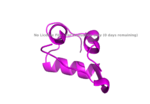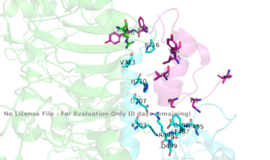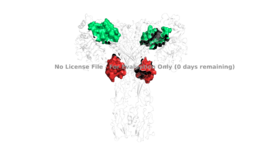Sandbox Reserved 1627
From Proteopedia
(Difference between revisions)
| Line 30: | Line 30: | ||
[[Image:Binding site with AA labeled.png|thumb|right|270px|Figure 3: Subunit interactions between the insulin receptor CT-alpha helix (light blue) and insulin (magenta) in one of the binding sites. [http://www.rcsb.org/structure/6sof PDB 6SOF]]] | [[Image:Binding site with AA labeled.png|thumb|right|270px|Figure 3: Subunit interactions between the insulin receptor CT-alpha helix (light blue) and insulin (magenta) in one of the binding sites. [http://www.rcsb.org/structure/6sof PDB 6SOF]]] | ||
The insulin receptor itself is held together by numerous critical disulfide bonds and [http://en.wikipedia.org/wiki/Salt_bridge_(protein_and_supramolecular) salt bridges]. These bonds maintain a stablized link between the dimers of the receptor, and without them, the conformation change from inactive to active would not be able to occur. One unique interaction within the receptor is known as a tripartite interaction. It occurs between the alpha-CT chain and the FnIII-1 domain region during a conformation chain, and involves the following residues:<scene name='83/832953/Alpha_ct_and_fniii-1/2'> ASP496, ARG498, and ASP99 on the FnIII domain</scene> and the <scene name='83/832953/Alpha_ct_and_fniii-1/3'>LYS703, GLU706, and ASP707 on the alpha-CT domain</scene> . This duo then interacts with the leucine rich region, L1, that exists on the opposing protomer of the dimer. | The insulin receptor itself is held together by numerous critical disulfide bonds and [http://en.wikipedia.org/wiki/Salt_bridge_(protein_and_supramolecular) salt bridges]. These bonds maintain a stablized link between the dimers of the receptor, and without them, the conformation change from inactive to active would not be able to occur. One unique interaction within the receptor is known as a tripartite interaction. It occurs between the alpha-CT chain and the FnIII-1 domain region during a conformation chain, and involves the following residues:<scene name='83/832953/Alpha_ct_and_fniii-1/2'> ASP496, ARG498, and ASP99 on the FnIII domain</scene> and the <scene name='83/832953/Alpha_ct_and_fniii-1/3'>LYS703, GLU706, and ASP707 on the alpha-CT domain</scene> . This duo then interacts with the leucine rich region, L1, that exists on the opposing protomer of the dimer. | ||
| - | [[Image:4 sites highlighted.png|thumb|right|260px|Figure 4: | + | [[Image:4 sites highlighted.png|thumb|right|260px|Figure 4: The presence of all four potential binding sides on the active insulin receptor: sites 1 and 1' (green) and sites 2, and 2'(red). [http://www.rcsb.org/structure/6sof PDB 6SOF]]] |
It is generally more common for only one or two insulin molecules to bind to the receptor due to the occurrence of negative affinity at the binding site, as well as the location of the second two binding sites on the back side of the receptor with Beta sheets and the lack of surface area they have. For this reason, studies support that optimal insulin receptor activation requires the binding of ligands to two insulin binding sites. Binding of at least one insulin is required for the activation of the insulin receptor and the change in conformation to the active T state. <ref> DOI 10.7554/eLife.48630 </ref>. | It is generally more common for only one or two insulin molecules to bind to the receptor due to the occurrence of negative affinity at the binding site, as well as the location of the second two binding sites on the back side of the receptor with Beta sheets and the lack of surface area they have. For this reason, studies support that optimal insulin receptor activation requires the binding of ligands to two insulin binding sites. Binding of at least one insulin is required for the activation of the insulin receptor and the change in conformation to the active T state. <ref> DOI 10.7554/eLife.48630 </ref>. | ||
| - | Ligand binding interactions are different at <scene name='83/832953/Sites_1_and_1_prime_location/ | + | Ligand binding interactions are different at <scene name='83/832953/Sites_1_and_1_prime_location/4'>sites 1 and 1'</scene> and <scene name='83/832953/Sites_2_and_2_prime_location/2'>sites 2 and 2'</scene> (Figure 4). The interactions at all 4 binding sites are highly hydrophobic, but there are differences between the sites. Binding sites 1 and 1' have two cystines in a disulfide bond linkage along with HIS B5 all from insulin interacting with <scene name='83/832953/Sites_1_and_1_prime_location/3'>PRO495, PHE497, ARG498</scene> residues from the FnIII-1 domain. At sites 2 and 2' the interaction with insulin involves more residues than at the first two sites. The FnIII-1 region has <scene name='83/832953/Sites_2_and_2_prime_location/3'>both basic residues-ARG479, LYS484, ARG488, ARG554- and hydrophobic residues- LEU486, LEU552, and PRO537</scene>- interacting with insulin's resides and numerous locations along its surface. |
== Relevance == | == Relevance == | ||
Revision as of 03:16, 7 April 2020
Homo sapiens Insulin Receptor
| |||||||||||
References
- ↑ 1.0 1.1 Tatulian SA. Structural Dynamics of Insulin Receptor and Transmembrane Signaling. Biochemistry. 2015 Sep 15;54(36):5523-32. doi: 10.1021/acs.biochem.5b00805. Epub , 2015 Sep 3. PMID:26322622 doi:http://dx.doi.org/10.1021/acs.biochem.5b00805
- ↑ 2.0 2.1 2.2 Uchikawa E, Choi E, Shang G, Yu H, Bai XC. Activation mechanism of the insulin receptor revealed by cryo-EM structure of the fully liganded receptor-ligand complex. Elife. 2019 Aug 22;8. pii: 48630. doi: 10.7554/eLife.48630. PMID:31436533 doi:http://dx.doi.org/10.7554/eLife.48630
- ↑ Weis F, Menting JG, Margetts MB, Chan SJ, Xu Y, Tennagels N, Wohlfart P, Langer T, Muller CW, Dreyer MK, Lawrence MC. The signalling conformation of the insulin receptor ectodomain. Nat Commun. 2018 Oct 24;9(1):4420. doi: 10.1038/s41467-018-06826-6. PMID:30356040 doi:http://dx.doi.org/10.1038/s41467-018-06826-6
- ↑ Uchikawa E, Choi E, Shang G, Yu H, Bai XC. Activation mechanism of the insulin receptor revealed by cryo-EM structure of the fully liganded receptor-ligand complex. Elife. 2019 Aug 22;8. pii: 48630. doi: 10.7554/eLife.48630. PMID:31436533 doi:http://dx.doi.org/10.7554/eLife.48630
- ↑ Wilcox G. Insulin and insulin resistance. Clin Biochem Rev. 2005 May;26(2):19-39. PMID:16278749
- ↑ Riddle MC. Treatment of diabetes with insulin. From art to science. West J Med. 1983 Jun;138(6):838-46. PMID:6351440
Student Contributors
- Harrison Smith
- Alyssa Ritter




